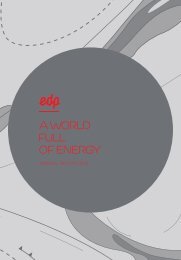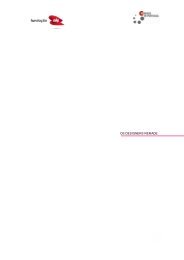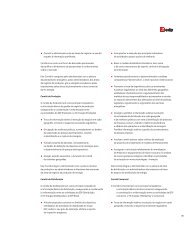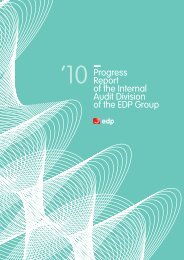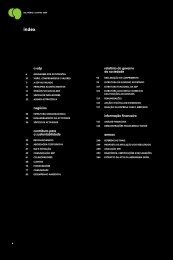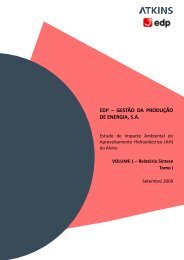business plan for 2004 - EDP
business plan for 2004 - EDP
business plan for 2004 - EDP
You also want an ePaper? Increase the reach of your titles
YUMPU automatically turns print PDFs into web optimized ePapers that Google loves.
2003 - Annual Report - <strong>EDP</strong><br />
Technical Service Quality<br />
With the objective of improving Technical Service Quality,<br />
<strong>EDP</strong> Distribuição decided to increase the investment in<br />
this area by about 20%. During 2003 there was a 50minute<br />
improvement in the Equivalent Interruption Time<br />
<strong>for</strong> Medium voltage Installed Power, or 12% compared<br />
with 2002, leading to a final figure of 370 minutes.<br />
Equivalent Interruption Time <strong>for</strong> Medium Voltage<br />
Installed Power minutes<br />
It should also be said that the violent fires that raged during<br />
the summer of 2003, which was declared a national<br />
disaster, affected a large number of distribution lines and<br />
imposed frequent electricity cuts both <strong>for</strong> safety reasons<br />
and at the request of entities involved in fighting the fires.<br />
There<strong>for</strong>e, the Equivalent Interruption Time referred to<br />
above includes about 29 minutes that can be attributed<br />
directly to these quite extraordinary causes outside of the<br />
control of the company. Excluding this effect, the final<br />
figure would have been 341 minutes, an improvement of<br />
79 minutes or 19% compared with 2002.<br />
<strong>EDP</strong> is committed to improving the Quality of the Service<br />
provided to its customers. The Quality of the Service<br />
provided is largely reflected in the parameters defined by<br />
the DGE as well as in the intangible experience of the<br />
customers when contacting the company via the different<br />
channels. During 2003 a number of projects were put into<br />
motion designed to bring the company closer to the needs<br />
expressed by consumers. There was there<strong>for</strong>e a significant<br />
reduction of energy interruption time that causes<br />
problems of various kinds <strong>for</strong> customers, often <strong>for</strong><br />
reasons independent of the company. Major investments<br />
were made in in<strong>for</strong>mation systems designed to improve<br />
damage response by the company, meter-reading<br />
reporting and collections. There was a focus on the<br />
attendance quality of the call centre, on greater efficiency<br />
in response to applications <strong>for</strong> the supply of electricity,<br />
and on the improvement and repair of infrastructures.<br />
Many of these projects have already been fruitful in terms<br />
of results. Others are pilot projects that are expected to be<br />
implemented on a larger scale during <strong>2004</strong>. In 2003 what<br />
was transmitted in-house and communicated to the<br />
outside world is that <strong>EDP</strong> will increasingly have to be the<br />
benchmark as far as the quality of its service is concerned<br />
because Quality is the basis of a solid company in an<br />
increasingly competitive market.<br />
Energy balance<br />
Energy distributed in 2003 totalled 38 869 GWh, 5.3%<br />
more than in 2002, of which 34 821 GWh in the SEP and<br />
4 048 GWh in the SENV.<br />
Energy sales in the SEP were down 3.1%. The very-high<br />
voltage segment saw the greatest growth rate, 27.4%,<br />
while the decline of the medium voltage segment reflects<br />
the transfer of customers to the SENV within the<br />
framework of growing liberalisation of the sector.<br />
Energy Balance<br />
<strong>EDP</strong> Distribuição GWh<br />
>> 1.1.4 Non-Binding Supply Activity<br />
2003 2002 Var. %<br />
Energy Delivered to the Distribution<br />
Network 42 207 39 941 5.7%<br />
Own consumption by Distribution (79) (46) (72.6%)<br />
Distribution losses (3 259) (2 990) (9.0%)<br />
Energy Leaving the Distribution Network 38 869 36 905 5.3%<br />
Sales of Energy at the SEP 34 821 35 947 (3.1%)<br />
Very high voltage 1 115 875 27.4%<br />
High voltage 3 640 3 396 7.2%<br />
Medium voltage 8 565 11 186 (23.4%)<br />
Special low voltage 3 042 2 880 5.6%<br />
Low voltage 17 293 16 530 4.6%<br />
Public lighting 1 166 1 080 7.9%<br />
Delivery of Energy at the SENV 4 048 958 322.6%<br />
<strong>EDP</strong> Group customers 2 724 644 323.2%<br />
Very high voltage 0 0 -<br />
High voltage 45 78 (41.6%)<br />
Medium voltage 2 679 566 373.3%<br />
Other customers 1 324 314 321.4%<br />
Very high voltage 0 0 -<br />
High voltage 68 104 (34.5%)<br />
Medium voltage 1 256 210 497.1%<br />
During the present stage of liberalisation of the market,<br />
that began on January 1, 2002, all customers connected to<br />
the grid in medium, high or very-high voltage are eligible,<br />
that is, they are free to choose their electricity supplier.<br />
Eligible consumption<br />
accounts <strong>for</strong> about 48.5%<br />
of national consumption.<br />
84/85






